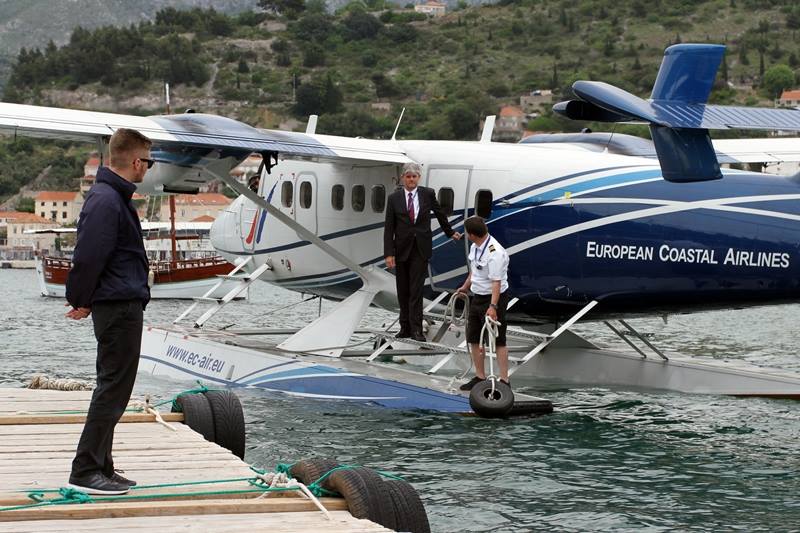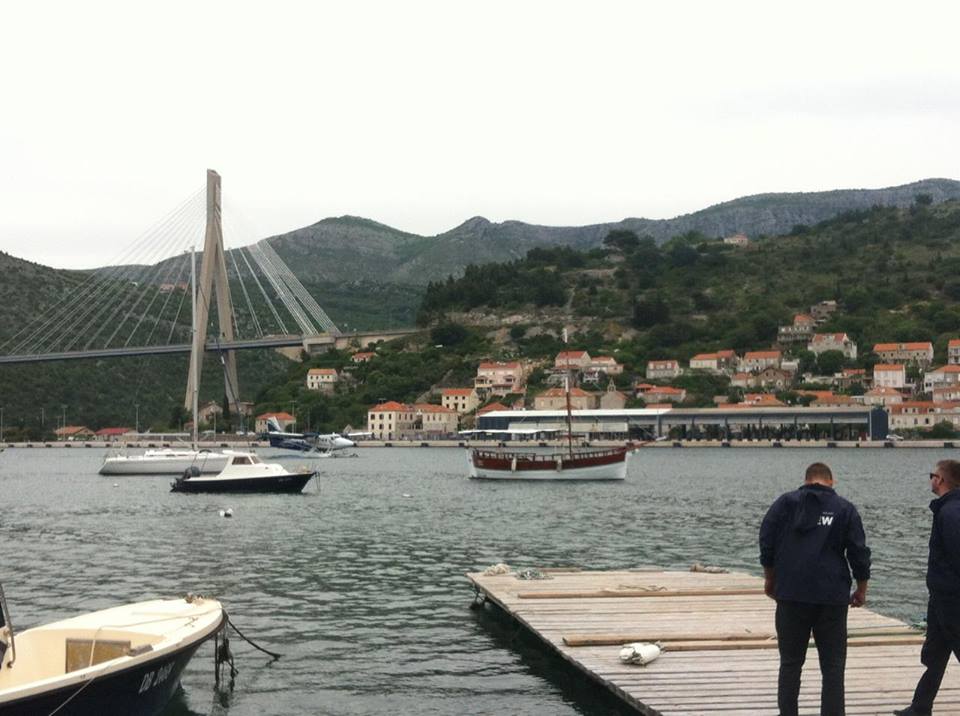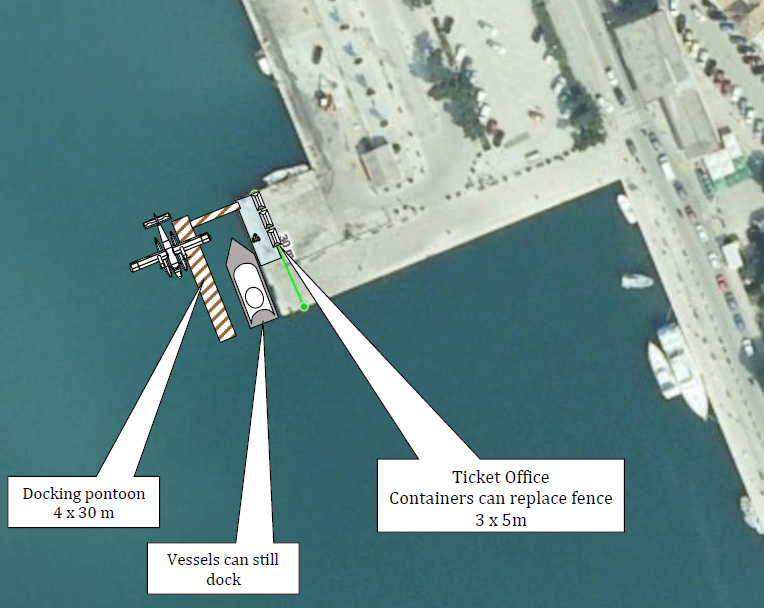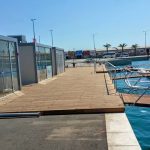A European Coastal Airlines seaplane landed in Dubrovnik’s port of Gruz on May 11, 2016, with some high-ranking Italian officials on board. With news on progress to extend the network to Albania, and seaports being establised in both Pescara and Ancona in record time by Croatian bureaucratic standards, what needs to be done to ensure that Dubrovnik is next to be added to the network after four years of negoatiations? TCN’s Ivana Sepak took to the skies over the Pearl of the Adriatic to find out.
It’s Tuesday, and one might think, just any ordinary day. For the second time, after an interval of one year, European Coastal Airlines came with their seaplane to port of Gruž, on this occasion with Mr. Luciano D’Alfonso, who is the president of Abruzzo region in Italy and also accompanied with the owner and director of ECA, Captain Klaus Dieter Martin. They came with ECA seaplane from Pescara. Normally, that journey would last a day, but now it took only 50 minutes to Split, where the crew needed to land and do the passport control since there is no infrastructure currently in Dubrovnik port that would support those activities. If there was a dock (pontoon) situated in Dubrovnik Gruž harbor, the crew and the passengers would come much earlier, and also, directly. TCN was exclusively on the site and thanks to Captain Martin and Dubrovnik’s port director, we were allowed on the seaplane to see what the capabilities of the plane are. Also, we got an exclusive from Mr. D’Alfonso and Captain Martin, who explained what is the actual meaning of the seaplane industry for locals, business and connectivity itself. Captain Martin explained to us, on the other hand what it’s like to be facing many obstacles doing business in Croatia. He can only be commended for his persistence and strong will. The conclusion is that the ball is in Dubrovnik port’s court and they are the ones that need to come to a decision. From March 1, ECA has been using the airport in Čilipi for flights to Split, but a tourism and business jewel as Dubrovnik needs something more.

TCN: Mr. D’Alfonso, could you please explain what was the impact of seaplanes for Pescara and how did it affect everybody, the locals, the business, the tourism?
I am sure the impact will be great for Croatia just like it was for us, we’re talking about connecting the sea and the sky. The connection on the level of transportation will be much greater now between Italy and Croatia’s interior, especially the Dubrovnik region that I have in mind, and it will bring benefits for both sides. I am also personally working a lot to set in motion the possibility of connection between Dubrovnik and Tirana. I believe the new concept of Europe will be based on transportation by land, by air, by sea, by all means. I am ready to do everything to reach this goal, even if it means signing the contract with the Devil himself.

TCN: Captain Martin, what do you expect from negotiations with Dubrovnik?
Well, we have been working with Dubrovnik as you know for many years now, and we’re trying and trying to get a location here at the sea. We started negotiations with Pescara about 3 months ago; we’ll be opening a seaport in 4 weeks time from today. It took us about 4-5 months to get everything organized. The county prefect of Abruzzo region has been very helpful, very supportive, we came here on an objective which is a little bit embarrassing, to be honest, and as we said, we’re working very closely with Albania to open connections down there, I’ve been talking to the transport minister of Albania, that we can have direct connections from Dubrovnik down to Durres, connecting down to Vlora and to Saranda, we’re also looking for direct connections from Dubrovnik over to Bari, Brindisi, and also from Dubrovnik over to Lastovo, and then over to Pescara.

So it’s an entire network that we’d be opening up here but unfortunately, it’s very difficult to find a solution here in the port of Dubrovnik, and I don’t understand why, because there is space, it’s so easy. It’s just a boat, it’s nothing else, it’s not an airplane, as soon as it touches the water, by law it’s a boat. It’s so easy, you saw it right now (op. ed. When the delegation landed next to yacht club Orsan), it was even quite tight, the plane can go in, it can go backwards, it can park very nicely, it’s very easy, and they’re just making rocket science out of it which I don’t think is justified, and they should give us a fair chance. And just to put it in the investment perspective right now: we have currently invested over 20 million Euros equity to develop the project, if I take the financing of the aircrafts on top of it, we’re running about 35 million Euros investment right now into the Croatian transportation system and we have over 100 employees. So, I don’t know why there is so much resistance. It’s about time that Dubrovnik woke up and found a solution. We have a very good contact now with the new transport minister, his assistant, Mrs. Fržop, she said she’ll help and it was a very constructive and a good talk and I’m quite positive she’ll be able to move the guys here to finally make a change.

TCN: how many jobs do you expect to open up in Dubrovnik, and will they be all year?
Yes, we fly all year round, obviously, in summer we fly more and in winter we fly less, but at the first step, we’ll have about 10 employees here, we’ll open a base here eventually because we’re going to have planes from Dubrovnik going early morning to Bari, to Brindisi, to Durres, so we’ll have an aircraft station here and then we’re talking about 22-30 jobs in Dubrovnik in the long run, not this year, but maybe 2018 we’ll have an aircraft station here, so the maintenance, to take care of the airplanes and everything.

TCN: you did receive a location offer under the bridge? Why did you not accept?
Yes, but that was just the location the city just suddenly decided: ok, we’ll put the seaplanes there. This position is impossible, we cannot operate there. An airplane does not have a problem with the wind, but the wind can come only from the front, that’s why an airplane has a tail in the back to keep the airplane exactly in the wind. If the wind is coming from the side, the airplane cannot handle wind from the side, that’s why the airplanes frequently cannot land in Dubrovnik airport and have to go somewhere else because the wind is coming from the side, so aircraft cannot operate in windy conditions when the wind comes from the side, you cannot turn the plane, so we cannot accept it (the location) and I told them it’s not safe, it’s not operationally ok, I will not invest any money there and I’ve told the city now, the županija, about 10-12 times and they have to get the message, it’s not safe there, and if it’s not safe, I will not do it. So we need just a docking location in the harbor and I don’t understand it, because, you know, every guy who has money can rent a yacht and he can come to the harbor and he can dock there for a week, for two days, whatever, and this is not a problem. But when a seaplane comes here to do commercial passenger transport, suddenly it’s not welcome.

So they are putting the passenger transport at a lower level than having rich people coming here with their yachts, use the harbor and they say: we have no space for you. I don’t understand because, you can see the harbor today, it’s empty, maybe there’s one month a year, August, or July and August, maybe then it’s full, but there is space for us and I would rather restrict the rich people with the yacht before I stop the whole transportation system which is going all year round, which is investing in the country, which is making jobs, which is bringing connectivity and so on, than just saying: we’ve got no space for you because 2 months a year there’s a yacht parking there where we would like to have a pontoon, I don’t understand and it’s very difficult for me as an investor, company manager and for my investors also to understand why there is so much resistance here. But once again I hope that with Mrs. Fržop supporting the project very much and we have had a very good talk to her and she’ll find a solution that the port here finally finds a space for us.
TCN: why did you bring along the župan from Abruzzo?
As you know, the big EU conference is here and he’s visiting the župan here as well as the EU members, and usually, it takes him a whole day to come to here. And now we had to go from Pescara to Split for passport control because we cannot come to port for passport control so we had to go to Split and then go to here. It took us one time 50 minutes and one time 40 minutes for the flight. We could have come also directly if we had a pontoon down here and a position where people could handle the flights.
TCN: how did it go with Mr. Pašalić, how about negotiations with him?
Well, he himself, as far as I know has his own problems with developing his marina there, so we’ll see how that develops and how that comes out. Maybe there would be a cooperation there and I think it’s the wrong side of the port because the public transportation is on the other side. So I think this is the more recreational side of the port and I’d prefer to have a pontoon on the other side of the port. We made several suggestions for the people there, for the port authority, for the city and now they have to make up their mind and find a solution and I hope it’s going to be soon that we can already have the transportation this year in the summer time with the islands, for the people, for the international traffic and to support the EU projects in the region.
TCN: Best of luck! Thank you!
Thank you!








